The National Fire Protection Association in its Standard for Chimneys, Fireplaces, Vents, and Solid Fuel-Burning Appliances standard (also known as NFPA-211) states that “Chimneys, fireplaces, and vents shall be inspected at least once a year.” The chimney or vent’s purpose is to provide “a flow sufficient to remove completely all flue or vent gases to the outside atmosphere.” A blocked chimney or vent could allow smoke and/or carbon monoxide to flow into the home instead of outside, so it is important to have your system checked out every year.
Having a chimney, fireplace, or vent inspected does not necessarily mean it also needs to be swept. The need for a chimney sweeping is dependent upon several factors, such as
- What type of fuel are you burning (wood or pellet)?
- How is it burned? Do you “bank” your stove (have long, slow fires by reducing air flow)?
- When was the last time you had your chimney swept?
- How much wood/pellets have you burned since your last sweeping?
- Are you experiencing any issues with your wood/pellet stove or fireplace?
A good “rule of thumb” is to have your chimney swept after you’ve burned 2 cords of wood or 2 tons of pellets. However, there are always exceptions to every “rule.” For example, if you “bank” your stove, the proper temperature and oxygen requirements for complete combustion are not met. This results in a thicker, denser smoke entering the flue. This smoke contains less heat, so it will cool quickly and condense before it reaches the outside atmosphere. The result is a heavy build-up of soot and creosote. This build-up will impact your draft because it is constricting air flow in the flue. You may start to notice that your stove is harder to start and/or you may experiencing smoking issues with your stove. Large amounts of creosote in a chimney flue or vent is dangerous. The dry, flaky type of creosote ignites easily and can cause a significant chimney fire. The hard, shiny black deposits of creosote are harder to ignite, but if they do, they burn with great intensity at extremely high temperatures, which will more than likely damage your flue. So, if you “bank” your stove, you may want to have your chimney swept more often than once a year if you use your stove often.
For pellet stoves, the main concern is the build-up of ash in the flue or vent. If left unchecked, the ash will build up to a point where the air flow becomes too constricted and the pellet stove will pull the air it needs down from the chimney instead of from the house. This results in ash “blow back” into the house. If the stove is running during an “ash blow back,” the ash will mix with the burning pellets and potentially damage the stove.
For oil burners and oil boilers, the flues should be inspected annually. However, under normal circumstances, the only times an oil flue would need to be swept is when there have been issues with the burner/boiler’s operation.
